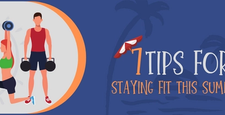How to Exercise in the Heat
With temperatures on the rise, many people are taking their workout outdoors in spite of the summer heat. From jogging to hiking, exercising outside is a nice change for many, but precautions should be taken to allow your body time to adapt to the new environment. This is because hot temperatures have an added effect on exercise tolerance, heart rate, muscle response and hydration levels.
For those who believe they are fit enough to exercise in elevated temperatures, consider this. The core body temperature of an average individual normally increases during exercise, but prolonged exposure to heat puts extra stress on the body, while higher humidity can suppress internal cooling systems. The results may lead to dangerously high internal body temperatures, while humidity prevents your body from releasing excess heat, which can lead to heat-related illnesses.
Summer heat can also leave you more susceptible to problems like muscle cramps, headache, weakness, confusion, nausea, rapid pulse and uncharacteristically increased heart rate, even for seasoned athletes. Luckily, the right exercise training will help increase your tolerance to heat with a better response time. (1)
Using sensible precautions like drinking more water than normal, adjusting your workout times and planning your workouts will help your body adapt. The following are sensible strategies to help increase your heat tolerance and stay safe in your new workout conditions.
Tips to Exercise in the Heat
Plan Your Workout
Planning your workout ahead of time can ensure you take the best precautions to exercise in the heat. Some things to consider include how long and the time of day you will exercise to avoid the most intense heat and smog. Update your workout gear such as layered clothing so you can strip items off as you heat up, or shoes and socks that will protect your feet from the outdoor environment. Also plan how you will hydrate; will you carry your water bottle, or use a fanny pack or other type of gear to hold it? Planning details like these can ensure you won’t be caught off-guard, so your workout is a safer one.
Adjust Your Workout Time and the Time You Workout
Adjusting your workout time might be the most important aspect of exercising in heat. In most climates, there are cooler times throughout the day and by contrast, times when the heat peaks. In many areas, the hottest time of day is from 10am to 3pm, while in other areas temperatures peak from 3pm to 5pm.
Be aware of daily fluctuations where you live and plan accordingly. Early morning hours tend to be the coolest with the best air quality, before all the traffic comes out. This can be an invigorating and refreshingly new way to begin your day. On the other hand, exercising in the cool of the evening can be a great way to wind down and lead to more restful sleep.
If you are used to exercising in a temperature-controlled environment, you may have to adjust the amount of time you work out, as well. Starting with a workout session of just 10 to 20 minutes when beginning your new outdoor routine will allow your body time to adjust to the new environment. As you work out, take it slow and be sure to pay attention to your body’s signals such as extreme sweating or excessive heart rate, and take breaks when needed.
Stay Hydrated
Keeping your body hydrated is important for any workout, but imperative for exercising in the heat. In fact, recommendations by the American Council on Exercise include drinking 17 to 20 ounces of water two hours before you exercise and then about 8 ounces every 15 to 20 minutes while exercising in heat.
Those who partake in strenuous or prolonged exercise should consider a low or no sugar sports drink to replenish electrolytes like potassium, chloride and sodium that are lost through sweat. Adding this habit can help you avoid muscle cramps and other heat related issues. However, don’t wait until you are thirsty to drink or you might be inviting problems.
Pay Attention to Your Body
While heat related problems can affect anyone, when temperatures rise above 90 degrees F, things can get dangerous. High levels of heat can lead to problems like heat stroke, which can be cause for hospitalization. Knowing the signs to watch for and using precautions can help you avoid these problems.
When you first begin to exercise outside or in the heat, pull back on your workout and allow your body time to adapt. Watch for signs like headache or pressure, elevated pulse, lightheadedness or dizziness, nausea and feeling overheated. Slow down or stop exercising if you feel any of these side effects. Know your limitations for exercise and heat tolerance, and if you are new to exercising, be extra cautious by allowing your body a full two weeks to adapt to the changes.
Dress Accordingly
Wearing the right gear can make a difference in endurance and performance. Exercising in the heat requires loose fit clothing, with wicking material if possible. This will allow your body to sweat if necessary and keep you warm enough if a cool breeze arises. If you go outdoors extra early, wear a light jacket that you can tie around your waist if it heats up.
Shoes and socks should also breathe to help you avoid blisters and athletes’ foot. Look for shoes with mesh materials and socks with material that will keep your feet both cool and dry while adding a cushioning effect at the same time. The right gear can help you focus on your workout while avoiding unnecessary discomfort.
Let Your Body Adapt
The main theme that permeates all of the above tips is to take it slow and pay attention. Allow your body time to adapt to exercising in the summer heat, so you can avoid heat-related illness. Before you know it, you will be stronger and more fit, and your body will be ready for any condition that challenges you.
And you are done! Oh and don't forget to rest.
References
1 Gleeson M. Temperature regulation during exercise. Int J Sports Med. 1998;19 Suppl 2:S96-S99. doi:10.1055/s-2007-971967



















